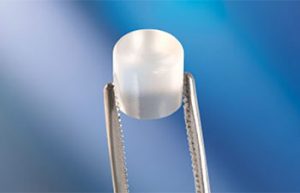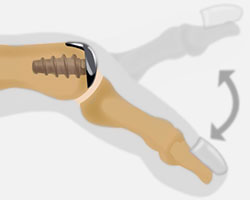
When the Cartiva Big Toe Joint Implant Fails (University Foot & Ankle Institute)
The Cartiva implant was considered to be a revolution in great toe arthritis therapy. It came out with a splash and the original studies to get the implant through FDA approval showed incredible results.
Our group, University Foot and Ankle Institute, and me in particular, were involved with helping launch the product and educating surgeons on how to use the implant. Initially, we were very excited to be involved but quickly realized there was something wrong.
WHAT IS CARTIVA?
The Cartiva implant is a mainly water based implant. It is placed in the great toe joint with a hole that is made into the metatarsal head. The implant is pressed fit into the hole and acts similar to regular cartilage, allowing motion of the joint.
The procedure is extremely easy to perform and reproducible in the operating room. It is also easy to teach and patients have a fairly rapid recovery after the surgery.
The original studies performed to get FDA clearance were extensive, with over 10 surgeons involved in the study. The results were amazing in the study. Almost all of the patients had pain relief and would do the procedure over again. The study blew my colleagues and me away.
WHY DOES THE CARTIVA IMPLANT FAIL?
The only problem with the Cartiva implant is that the results we saw at our institutes were far less successful than those noted in Cartiva’s studies. We were seeing failures due to the implant slipping into the bone, a process referred to as subsidence.
Advancement in Great Toe Arthritis, Hallux Limitus and Hallux RigidusThe implant would be left 2-3mm out from the surface of the bone during surgery and it was definitely outside of the bone following surgery. However sometimes, even on the first visit after surgery, the implant had sunken into the bone. We were far from the only ones noticing this occurring.
We ordered MRI and CT scans to figure out why the implant was failing. We also reached out to other early adopters and learned they were having similar issue. Our results were very different from the original study.
We felt compelled to find out what was going wrong and we reached out to the company and alerted them to the issues. I recently met with the company that owns Cartiva and its representatives at a national foot and ankle meeting. I alerted them to the issues and mass failures we are seeing and suggested they see why this is happening. They were very courteous but less than interested and began to quote studies saying the implant and their internal studies are great.
WHY UNIVERSITY FOOT AND ANKLE INSTITUTE NO LONGER USES THE CARTIVA IMPLANT

Cartiva, a synthetic cartilage implant that can used to treat great toe arthritis.
This made me think that as a foot and ankle surgeon, I am morally obligated to report this issue to the manufacturer, to our patients, blog readers and the general public. This issue must be investigated by the manufacturer and they must help those with failures find hope and get out of pain.
As a result of this, we have decided that the Cartiva implant’s real-world results are not up to our standards and we have stopped using them. Over time, we have begun removing the implant and replacing it with other options. Now that we have seen A LOT of other surgeons’ patients coming to our clinics with the same issues, we feel this is an epidemic problem.
The goal of this article is to help those who have a failed Cartiva implant and to tell those who want to get one to NOT GET A CARTIVA IMPLANT until further notice. We can now see that about 50% of the implants we have done have failed. This is far below our normal 90% to 95% surgical success rate for the most complicated cases and the most advanced technologies. That is what we and our patients expect. Anything lower is not acceptable.
WHAT TO DO IF YOU HAVE A FAILED CARTIVA IMPLANT?
The good news here is it’s fixable. There are multiple companies working on replacement systems if you must have a toe joint replacement. I will detail these further. If you just want to be out of pain, get on with your life and have no more issues, your best option is a great toe joint fusion. Fusions work great when done right. A woman can wear a 2-inch pump following a fusion, and for men it is the best surgical option.
ARTHOSURFACE IMPLANT FOR FAILED CARTIVA IMPLANTS

UFAI’s preferred procedure is Arthrosurface.
If you are a patient who really wants the toe to move, Arthrosurface has devised a special implant to fill the Cartiva hole and fit a replacement on it. The original Arthrosurface implant had an 8mm stem on it and was not able to be placed in the 10mm Cartiva hole.
At the last national meeting, we discussed this with the Arthrosurface team, and I am happy to report that we now have a 10mm stem that fits into the Cartiva hole. This implant is a wonderful joint replacement system that is very strong and sturdy, works well and allows for immediate weight bearing. We like the Arthrosurface implant, as the best option for a failed Cartiva in the case a patient does not want a joint fusion.
MY PERSONAL THOUGHTS ABOUT JOINT FUSION
I would not be doing my job for my patients if I didn’t speak about joint fusions as an option. Any implant will fail with time and wear and tear. A fusion will not. Any implant can get damaged with pounding and hard exercise. A joint fusion will not. Any implant will need to be replaced again, if only because of time. A joint fusion will not.
If you are a man and you do not need to go on your toes for any major reason, fuse your toe. If you are a woman and don’t need to wear more than a 2-inch heel, fuse your toe. This will allow you to be out of pain and get on with your life with no setbacks and no need for further surgery.
I hope this article is helpful and gives patients suffering Cartiva failure hope. Ultimately, my suggestion is do not do a Cartiva implant. It is not worth the risk. For those who experienced a failed Cartiva implant, I suggest you strongly consider fusing the great toe as it will be a one and done surgery with an exceptional outcome potential.
If motion of a toe is a must, try the Arthrosurface implant and make sure your surgeon is aware of the 10mm new stem option, which is a must for proper replacement of the Cartiva implant.
If you would like more information about treatment options for big toe arthritis, please call us at (877) 736-6001 or visit us at www.footankleinstitute.com.

Dr. Bob Baravarian, DPM, FACFAS
Dr. Bob Baravarian is a Board Certified Podiatric Foot and Ankle Specialist. He is currently a member of UCLA Medical Group, Chief of Podiatric Surgery at Santa Monica/UCLA medical center and Orthopedic Hospital and an assistant clinical professor at the UCLA School of Medicine. He also serves as co-director of University Foot and Ankle Institute. He is Editor Emeritus of the international medical journal, Foot and Ankle Specialist.
Dr. Baravarian has been involved in athletics his entire life and played competitive tennis in high school and college. He has an interest in sports medicine, arthritis therapy and trauma/reconstructive surgery of the foot and ankle. He servers as a consultant to the ATP (Association of Tennis Professionals) tour, multiple running organizations and several shoe manufacturers. He is also fluent in five languages (English, French, Spanish, Farsi and Hebrew),
Podiatrist Dr. Bob Baravarian is available for consultation at the Santa Monica, Sherman Oaks and UCLA Westwood offices.

